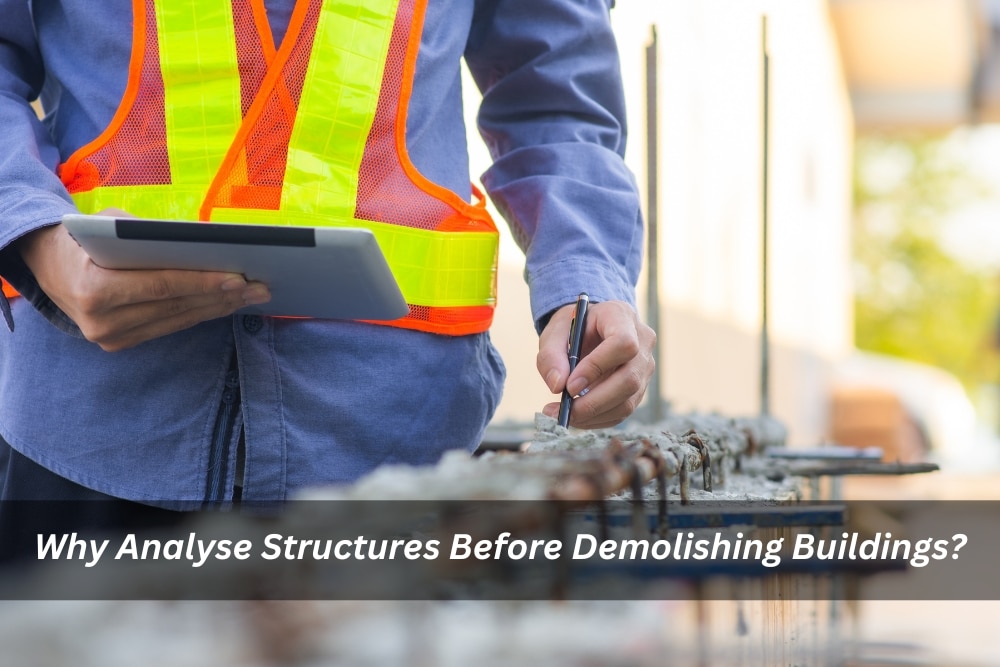G’day, esteemed readers! Ever pondered the intricacies that unfold before we give a building in Sydney the old heave-ho? It’s not just about tossing a wrecking ball around and yelling “Timber!” There’s a whole process involved, and one of the critical components in this pre-demolition jig is the structural analysis of a building. So, grab a cuppa, and let me regale you with the tale of why comprehending the ins and outs of a structure is as crucial as your morning caffeine fix before we embark on the demolition journey.
Ever heard of a controlled collapse gone wrong?
Now, knocking down a building might sound like a piece of cake, but let me tell ya, it can turn into a right mess if not done with a bit of precision. Picture a controlled collapse that’s supposed to go off without a hitch – but oops, it’s like trying to wrangle a kangaroo in a supermarket. That’s where structural analysis comes into play, making sure the demolition dance is more Waltzing Matilda and less chaotic kangaroo tango.
Okay, but what exactly is a structural analysis of a building?
Now, you might be thinking, “What’s the big deal with structural analysis?” Well, it’s like giving a thorough health check to a building before deciding its fate. It’s about digging into the materials, the guts, and the potential weak points. Think of it as a check-up that helps us figure out the best way to chuck the building in the skip.
Why does this analysis matter more than a pre-demolition high five?
- No surprises, Mate: Starting a game without knowing the rules is like demolishing a building without structural analysis. Unexpected problems can lead to delays that are more frustrating than trying to herd sheep in the rain.
- Using your noggin: It’s not just about swinging a wrecking ball; it’s about using the right tools for the job. Structural analysis helps us allocate resources properly, like figuring out which tools are ripper and which ones are just a bit dodgy.
- Safety first, always: Buildings, like a good pair of thongs, can wear out over time. Structural analysis helps us spot potential dangers and plan things out so nobody ends up in the deep end.
So, how do you analyse a building before demolition? Tools of the trade for budding demolition detectives
Before we let the demolition crew go wild, we need to do a bit of detective work to suss out the building’s condition. Let’s get our hands dirty and dive into the detective work that comes before the wrecking ball’s grand entrance.
- Visual inspection: The Sherlock Holmes Approach to cracks and clues
Imagine you’re Sherlock Holmes, but instead of a magnifying glass, you’ve got a hard hat. Visual inspection is like scrutinising the building for any dodgy-looking cracks, sagging bits, or anything that screams “Oi, I’m about to collapse!” It’s the first step in figuring out what’s lurking beneath the surface.
- Non-destructive testing: Unearthing hidden weaknesses without hammering a nail
- Ultrasound: Like a medical ultrasound, this technique uses sound waves to detect hidden flaws in concrete and steel. It’s like giving the building an X-ray without the radiation.
- Infrared Thermography: Think of it as the building’s thermal selfie. It helps us spot insulation issues and water leaks, which are like finding a kangaroo in a haystack.
- Destructive testing: When you need to get up close and personal with the problem
- Core sampling: Sometimes, you’ve got to take a piece of the building for a gander. Core sampling involves extracting cylindrical pieces to inspect the materials and their integrity – like snagging a sample from a meat pie.
- Load testing: Put the building under stress (controlled stress, of course) to assess its response. It’s like giving the building a fair dinkum stress test to see if it can handle the pressure.
Beyond the basics: When should you call in the structural analysis team?
Structural analysis isn’t one-size-fits-all, mate. Here are times when calling in the experts becomes fair dinkum crucial.
- Age and Ailments: When Time Takes Its Toll on Concrete and Steel
- Corrosion and rust: Metals rust, and concrete crumbles over time. Structural analysis helps us figure out if it’s just a bit of surface rust or a full-blown Aussie-style deterioration.
- Foundation failures: The building’s foundation is its backbone. If it’s in the blink, the whole shebang is at risk of going belly up.
- Material Mysteries: Asbestos, Lead, and Other Hidden Hazards
-
- Asbestos: Common in older buildings, asbestos is like the Vegemite of construction – it’s everywhere. Structural analysis helps us spot it and plan for a safe removal, no worries.
- Lead paint: Another sneaky threat. Analysis helps us figure out the safest way to deal with materials that have more lead than a pencil factory.
- Architectural Enigmas: Dealing with Unique Designs and Historical Structures
-
- Preservation challenges: Historical buildings often present unique challenges. Structural analysis helps us find the balance between keeping the history alive and making sure the building doesn’t go walkabout.
- Unconventional designs: Buildings with unique designs might have hidden quirks. Analysis ensures a safe approach to demolition without turning it into a dingo’s breakfast.
Arm yourself with knowledge: Resources to ace your building’s structural analysis
Before you jump into the structural analysis game, it’s essential to know where to get the good oil.
- From permits to Professionals: Navigating the regulatory landscape
-
- Building Codes: Understand the local building codes and regulations governing demolition – it’s like learning the local lingo before you hit the pub.
- Permits: Make sure you’ve got the necessary permits before you start tearing down walls – you don’t want the council on your case like a seagull after a chip.
- DIY or call in the Pros? Weighing the options for optimal analysis
-
- Complexity of the project: Simple structures might allow for a DIY approach, but if it’s as complex as a game of knife-spoony, call in the experts.
- Budget considerations: Pros might cost a few extra quid, but trust me, the cost of stuffing up the analysis can be more than a round of drinks at the local.
- Learning Resources: Books, websites, and courses for building your demolition IQ
-
- Books: “Structural Analysis for Dummies” and “Demolition: The A to Z Guide” are beaut starting points.
- Websites: Check out reputable websites for in-depth info.
- Courses: Online courses on structural analysis and demolition are like a barbie with all the fixings – a ripper way to build up your knowledge.
Demolition done right: The takeaway for responsible builders and curious citizens
- Safety First, Cobber: Keep safety at the forefront – for the workers, the locals, and anyone in the vicinity.
- Eco-Friendly Demolition: Be a good bloke to the environment by recycling materials and handling hazardous stuff like a baby koala.
- Keep the Mob in the Loop: Let the community know what’s going on. Communication is key to avoiding a rowdy pub brawl – or, in this case, a rowdy neighbourhood.
Conclusion
So, in the world of construction and demolition, there’s more to it than chucking a few shrimp on the barbie. Structural analysis is the secret sauce that ensures our demolition shindig is a bonza show. Next time you see a building coming down, remember the hard yakka that went on behind the scenes. Because in the world of demolition, knowledge isn’t just power; it’s the key to pulling off a ripper, safe, and fair dinkum demolition project. Cheers, legends!
Ready to turn those dilapidated structures into history? Look no further than Watson Demolition & Site Services, where we’re not just talking the talk, but we’re swinging the wrecking ball! Our team is geared up and ready to tackle any demolition project, ensuring it’s as smooth as a cold brew on a scorching arvo. Trust us to bring down the building – literally – with our top-notch expertise and commitment to safety. No surprises, no muckin’ about, just fair dinkum demolition done right. Give us a bell, and let’s kick off your demolition project with a bang! Cheers!



